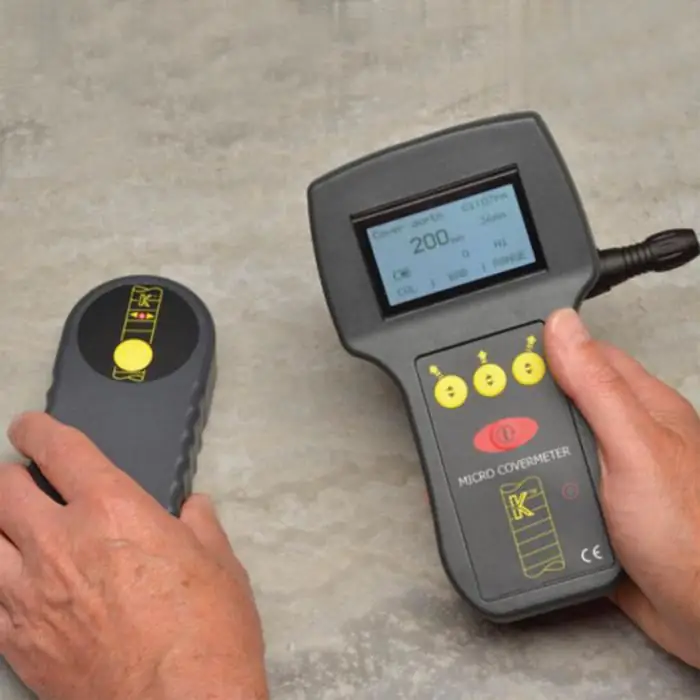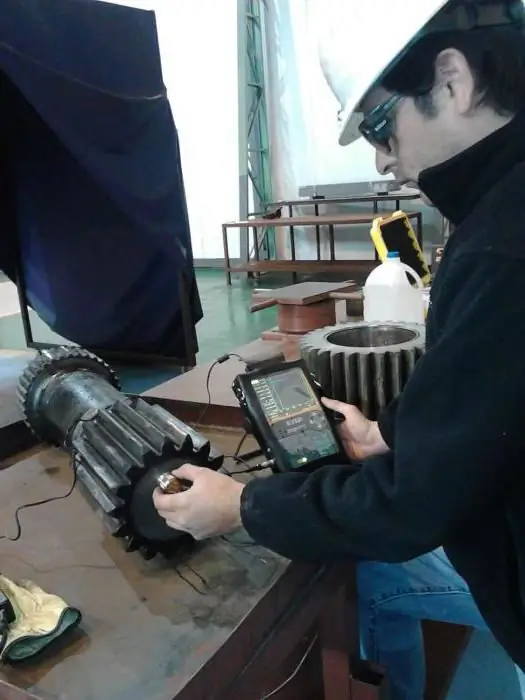2026 Author: Howard Calhoun | [email protected]. Last modified: 2025-01-24 13:10:30
The problem of the quality of the road surface in our country is extremely acute. Therefore, it is very important when accepting the work of construction services to qualitatively and correctly test reinforced concrete. And based on the results of these works, a decision should already be made on the commissioning of road transport infrastructure facilities. In this article, we will just talk about the features and rules (GOST) of testing asph alt concrete.

Basics
To check the compliance of the pavement with accepted standards, it is necessary to make special samples, the shape and geometric dimensions of which are strictly specified. This will avoid the occurrence of measurement errors. In this case, the material is subjected to significant pressure in order to compact. However, in some cases, asph alt concrete tests are carried out on the material without pressure hardening. After all, the physical and mechanical properties of the mixture are establishedfor all its conditions, and if the material does not meet the standards, then the finished coating will not be able to provide either reliable grip for vehicle tires or safe movement in various weather conditions.
In some cases, it is necessary to use not specially made samples, but cores cut from a real road surface. Tests of asph alt concrete in this case will allow fixing the discrepancy between the characteristics of the declared and established requirements.

Some features of sample mix production
Testing asph alt concrete should only be carried out on correctly made samples. The mixture is produced using an electric agitator equipped with heating elements to maintain the required process temperatures.
Before being placed in the mixer, all components must be dried and heated to certain temperatures. Depending on the type of mixture, the material can be heated from 80 to 170 degrees Celsius.
The binder is mixed with minerals before being placed in the device. This work is carried out manually by the plant operator. It is simply impossible to mix the mixture well with your hands, therefore, after mixing with a spatula, the resulting substance is loaded into a special laboratory mixer. The time required for uniform mixing of all components of the mixture can vary significantly depending on the binder and components used (from three to six minutes).
Composition testpavement samples
This test allows you to fairly accurately determine the percentage of minerals and binders in samples (samples) of the road surface.
The mineral content is determined using the so-called extraction method.
To carry out the work, you will need an accurate electronic scale, a special extraction nozzle, an oven, a refrigerator, a porcelain crucible, solvents and a sufficient amount of cotton wool.
In preparation for this test, the samples must be dried very well. To do this, they are twisted into three, and preferably four layers of filter paper and placed in a drying cabinet for a certain time.
A glass vessel filled with solvent is heated to the boiling temperature of the contents. Since the solvent is flammable, heating must be carried out in a sand bath to ensure safety. When hot solvent is applied to the sample, it extracts and removes the binder from the asph alt concrete. The procedure is repeated until the solvent stops changing color. It remains only to weigh the minerals and calculate their mass fraction.
Hydrostatic weighing method
This coating test method is one of the most common due to its ease of implementation, low cost and demonstration. In accordance with GOST, testing of asph alt concrete by hydrostatic weighing can be carried out both on cores cut from a real coating, and on specially made in laboratorysample conditions.
Research is carried out to determine the density of asph alt concrete, taking into account the pores throughout the entire volume of the sample. The fact is that their number and size cannot be accurately and quickly determined by any diagnostic methods. But density is one of the most important indicators regulated by GOST and industry standards.
Thin holes must be drilled in all specimens. Then a thread is threaded through these holes and weighed in air. Accuracy of weight indicators up to three decimal places is required, therefore it is recommended to use modern electronic scales with high accuracy. The samples are then weighed in water. However, before the procedure, it is necessary to keep them in the liquid for 30 minutes so that they are saturated with water. Further, the process can proceed according to two scenarios: weighing the impregnated samples in air or in water. Depending on the adopted technology, the calculation technique will vary.
This method has been known for a very long time, but is still actively used by leading laboratories around the world.

Calculation of the density of reinforcing minerals in the coating composition
When testing asph alt concrete, the laboratory necessarily carries out a set of measures to determine the specific gravity of minerals in the mixture. This technique is computational, but, despite the lack of experimental data, it plays a very important role in assessing the quality of road surfaces of various types and consistency.
Calculation is based onreference data on the density and other characteristics of each of the minerals that make up the mixture. When choosing the density indicators of the individual components of the mixture, one should be guided exclusively by state standards in this area (GOST). If you take data from other sources, this will lead to an erroneous conclusion and making the wrong decision on the part of the management and executors of construction or research work. Of course, the mass fractions of the components will also be taken into account.
Can density be determined by calculation?
Laboratory testing of asph alt concrete requires expensive equipment. And not every organization can afford the purchase of such equipment. Therefore, in some cases it is allowed to determine the values of certain quantities by the calculation method. This method may not give accuracy to a few decimal places, but it still allows you to determine the degree of coverage quality.
So, to determine the total density of asph alt, you can use the simplest formula. The main thing is to know the density of the binder, as well as the proportions and composition of the mineral sealant.

Pycnometric method for determining the density of asph alt. What is its essence?
This method is quite applicable, because it is regulated by GOST. The method of testing asph alt concrete requires grinding samples (cores) of the coating to a certain size. Further, with the help of high-precision electronic scales, it is necessary to obtain two samples weighing 100 g. The error in this case should notexceed one hundredth of a gram.
The resulting mixture is placed in a glass flask with known characteristics (mass, weight, volume, and so on). The flask is filled with water about one third. The resulting mixture must be thoroughly mixed by shaking in the hands, after which a series of manipulations is carried out.

Why and how is a swelling test performed?
Such a test of asph alt concrete samples as swelling is also mandatory. If this indicator is exceeded, then this will not only affect the life of the transport infrastructure, but also pose a threat to the life and he alth of people.
The principle is based on comparing the geometry of the material before and after moisture saturation. To carry out such experiments, a drying oven is required.
The indicator is calculated using a simple formula.
The same sample is alternately weighed first in air and then in water. After that, the sample stays in the liquid for some time and is saturated. After a few hours, the sample is reweighed in air and water. The received data is substituted into the formula.
Testing the pavement for water resistance
This test is performed on samples after very long exposure to water. More precisely, this test compares the strength characteristics of dry samples with the characteristics of cores that have been in a water bath for at least 15 days.
For the test you will need a vacuumdryer, mercury laboratory thermometer and powerful hydraulic press.
How to determine the water absorption capacity of a material?
The protocol for testing asph alt concrete without fail requires the results of experiments to determine the water-saturating capacity of the road surface. This is a very important indicator. The amount of absorbed liquid significantly depends not only on the material itself, but also on the saturation conditions (primarily temperature and pressure).
This test method requires a high-precision balance, a vacuum oven, a mercury thermometer and a glass flask of sufficient volume in the laboratory.
The principle is based on determining the change in the mass of the sample before and after saturation. Knowing the density of water, as well as the mass of a dry sample, it is very easy and simple to determine this indicator.

Compressive strength test method for asph alt concrete
The compression resistance index is one of the most important. It is taking into account its value that the modes of operation of roads, the maximum load on the axle of vehicles, and so on are set.
The essence of the test is that the sample is subjected to compression on a powerful press until a destructive process begins to occur.
The prepared pavement sample is placed on the press plate. The upper plate is brought to the surface of the sample at a distance of 1-2 millimeters. Only after these steps can you enablehydraulic drive. Metal plates absorb heat well, which can affect the purity of the experiment. To minimize the error, it is recommended to heat the press plates to the specified temperatures. However, this possibility is not always available. You can put a piece of paper on the stove. This measure will also minimize the heat loss of asph alt concrete.

Preparatory work for pressure testing
First of all, you need to prepare samples. Depending on the goals, these can be both cores from the finished road surface, and laboratory-made material for research.
Before proceeding directly to compression tests, it is necessary to hold the samples at a certain temperature (50, 20 or 0 degrees Celsius). The exposure time may vary. Thus, it is enough to withstand cold coating samples for one hour. A hot coating (we are talking about manufacturing technology) must be kept in a heating device for at least two hours. If it is necessary to keep the samples at zero temperature, then they are placed in ice water.
Required equipment and apparatus for testing compressive load resistance
It is necessary to have a powerful (about 100 kN) hydraulic press in the arsenal with the ability to adjust the force in small increments.
Since testing of cast asph alt concrete must be carried out under various temperature conditions, it is necessary that mercurythermometer. Mercury belongs to the class of hazardous substances. Therefore, the availability of such devices requires obtaining permits, training and retraining of laboratory personnel on the rules for the operation and maintenance of mercury devices for various purposes.
During the test, you will also need special thermostatic containers with a volume of at least eight liters.
Recommended:
Asph alt concrete pavement: technology and instructions

The road, made on the basis of asph alt concrete mixture, is considered one of the most profitable pavements. It is practical, inexpensive and generally allows you to provide the characteristics necessary for operation
Concrete strength meters. Concrete testing methods

When constructing buildings and structures, it is very important to monitor the strength of concrete. For this, special devices are used. Measurement parameters can vary quite a lot
Asph alt production: technology. asph alt concrete plant

Large-scale production of asph alt on the territory of the Russian Federation has been carried out since 2013. This year, it was decided to launch several government projects, which included the laying of new road routes, as well as the repair of old highways
Ultrasonic testing of welded joints, methods and technology of testing

Ultrasonic testing - advanced technology for the study of welding joints and seams. It will be discussed in this article
Asph alt density. Asph alt composition, GOST, grades, characteristics

The density of asph alt is 1.1 g/cm³. The melting point can vary from 20 to 100 °C. The composition contains oil in a volume of 25 to 40%, as well as a resinous-asph altene substance, which can be contained in a volume of 60 to 75%

